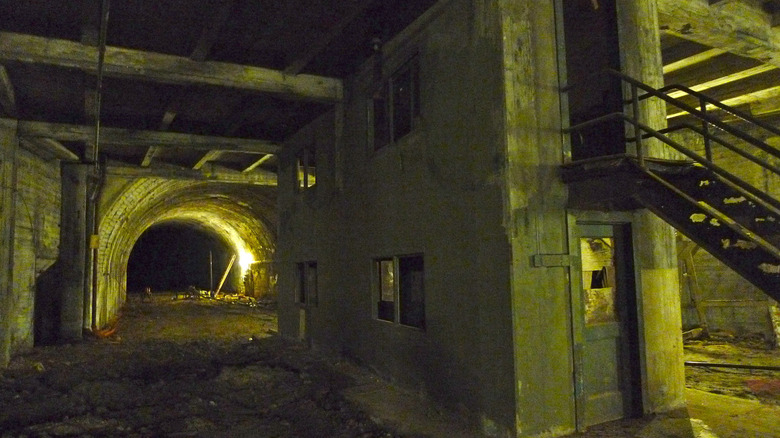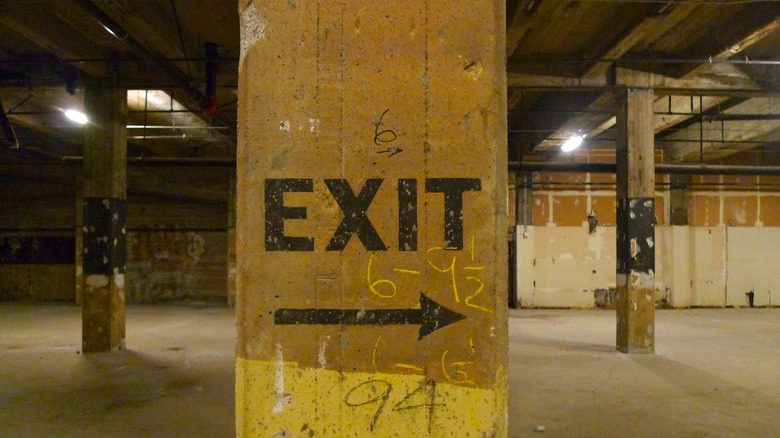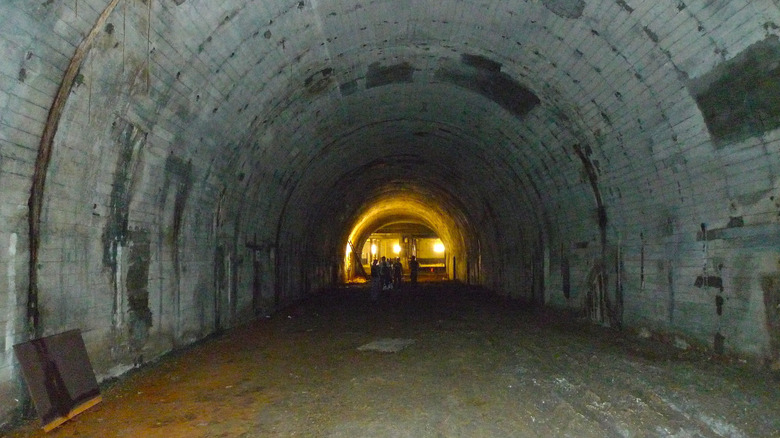The Secret Tunnels Of LA's Prohibition-Era Bar Scene
For those living in Los Angeles, or even those who've visited, we've got some shocking news for you: LA has a metro. "Whoa" is right, especially for a city so car-obsessed, car-dependent, and focused on, shall we say, surface-level things. But for all the concrete, glass, glitz, and Hollywood splendor that spreads across the surface of the City of Angels, there's a surprising amount of subterranean dirt, grime, and dank tunnels bored beneath the streets. You can't visit this network of crosshatched passageways anymore, at least not legally, but it's certainly fun to imagine them sprawled beneath everything exposed to the sun.
In fact, these tunnels spread under Los Angeles used to be working railways belonging to two separate lines: the Pacific Electric Red Car and the Los Angeles Railway Yellow Car. They stayed in use from the late 19th century all the way to the 1960s. The entire underground complex still looks vaguely like a collection of train stations connected by tracks, minus 60 years of disservice, disrepair, and neglect. Atlas Obscura says that these tunnels were not only used for trains but also to smuggle goods during the U.S.' foolhardy attempt to legally deprive its citizenry of alcohol from 1920 to 1933: Prohibition. While the world above languished in a dry, dull, sober stupor, the world below whooped it up. Over the decades these tunnels were also reportedly used by police to transport prisoners, the mob to dump bodies, banks to scuttle around cash, and more.
[Featured image by Alissa Walker via Flickr | Cropped and scaled | CC BY-NC-SA 2.0]
Speakeasy access to an underground labyrinth
Just to be clear, there aren't just a handful of now-abandoned tunnels underneath Los Angeles — Drivin' & Vibin' says that there are 11 miles worth of tunnels stretching this way and that way underneath the city's downtown. That's plenty of space for Prohibition-era bootleggers and patrons to hide, store, transport, distill, guzzle, etc., entire breweries' worth of booze. Not that everyone during Prohibition in LA had to spelunk to have a gin and tonic. Various aboveground, liquor-flush establishments populated the LA landscape, like Townhouse in Venice or the 1906-born King Eddy Saloon, which masqueraded as a piano shop until 1933. Places like those became LA historical staples, although King Eddy's got gobbled up by Skid Row in the following decades and has since closed, if Yelp reviews are any indication.
Prohibition-era customers seeking something a bit more heady than the legal goods advertised on storefronts often passed into a basement-level speakeasy where they could drink in peace. Drivin' & Vibin' says that customers headed to the speakeasy under the aforementioned Townhouse slipped through an actual trap door in the floor and into a room that served no more than two people at a time. Atlas Obscura says that King Eddy's Saloon, by contrast, had a full basement that connected directly to LA's underground tunnel system. Those passages interwove with LA's old railway lines.
[Featured image by Alissa Walker via Flickr | Cropped and scaled | CC BY-NC-SA 2.0]
Apocalypse bunker meets urban explorer's dream
Folks got a good glimpse of Los Angeles' extensive, abandoned underground tunnel network following a detailed blog post by writer Alissa Walker, who provided readers with a bevy of photos to boot, as Deserted Places shows. The photos show sections that look very much like once-decorated and beautiful subway platforms, areas that look like decayed warehouse rooms, and others that look like nuclear fallout bunkers. It's a good thing we've got such photos, too, because Drivin' & Vibin' and Atlas Obscura both concur that these tunnels are no longer open to the public. They are, however, still in regular use by city employees as maintenance tunnels, which is presumably a better option for cutting across LA than getting stuck in the city's endless bumper-to-bumper traffic.
However, that doesn't mean that would-be urban explorers have to forego their dreams of visiting the ruins under the streets of LA. Just "slip behind" the Los Angeles County Hall of Records on Temple Street, as Atlas Obscura says, and find a conveniently located elevator. Elsewhere, Drivin & Vibin' reports that there's another handy elevator at 222 North Hill Street heading down to an escalator that you can take up to the tunnels. Or, if you don't want to run the risk of getting caught trespassing, Cartwheel Art Tours does two-and-a-half-hour custom walking tours in the tunnels for $85 per person.
[Featured image by Alissa Walker via Flickr | Cropped and scaled | CC BY-NC-SA 2.0]


